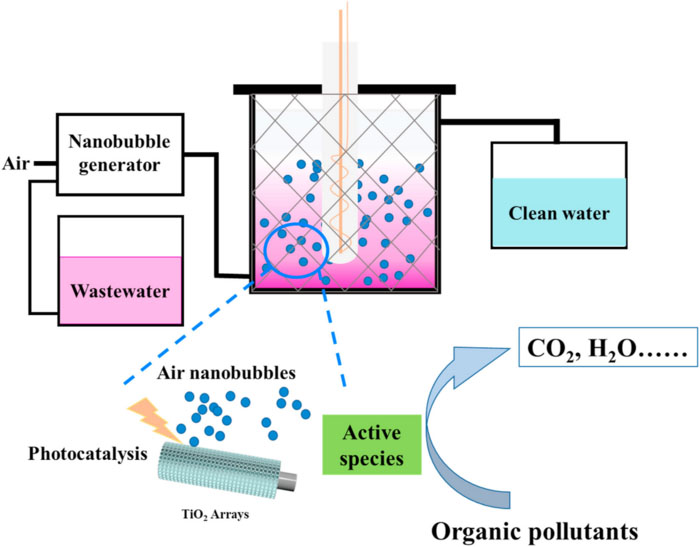| May 16, 2023 |
Efficient wastewater treatment with nanobubble-integrated TiO2 photocatalytic reactor
(Nanowerk News) Urbanization and industrialization have led to escalating environmental issues, with dye wastewater, due to its high toxicity, posing a significant challenge. Traditional treatment methods, including physical, biological, and chemical approaches, are inadequate due to inefficiencies, high energy consumption, and incomplete remediation. Therefore, there's a pressing need for alternative sewage treatment techniques.
|
|
In 1972, Fujishima pioneered the use of titanium dioxide (TiO2) in photocatalytic decomposition of water for hydrogen production. Since then, photocatalytic technology has evolved for wastewater treatment applications, leveraging its effective mineralization ability, fast reaction rate, and lack of secondary pollution.
|
|
TiO2, being non-toxic, chemically stable, and low-cost, is a widely used photocatalyst. To transition this technology from experimental research to practical application, the design of a simple, efficient, and easily assembled photocatalic reactor is crucial.
|
|
Recent advancements have seen the integration of photocatalytic technology with various advanced oxidation processes (AOPs) to enhance performance. Coupling TiO2-based photocatalysis with AOPs like Fenton oxidation, plasma oxidation, and ozone oxidation has shown improved treatment of organic pollutants.
|
|
Nanobubbles (NBs), due to their unique physical properties, have also proven beneficial in wastewater treatment, enhancing the photocatalytic performance of TiO2 by 11.6% compared to non-bubble methods.
|
|
However, a major challenge is the need for re-separation and recovery of TiO2 post-degradation, complicating the reactor design. To circumvent this issue, a fixed photocatalyst is necessary for the reactor assembly.
|
|
In this study (Advanced Sensor and Energy Materials, "Degradation of Rhodamine B in the photocatalytic reactor containing TiO2 nanotube arrays coupled with nanobubbles"), a TiO2 nanotube array coated titanium mesh was used to assemble a photocatalytic reactor integrated with nanobubbles technology.
|
 |
| Schematic diagram of the photocatalytic reactor coupling with nanobubbles for degradation of the organic pollutants. The cylindrical reactor was made of stainless steel with a diameter of 210 mm and a height of 210 mm. The Ti meshes (100 mm in length, 100 mm in width, and 0.5 mm in thickness) coated with TiO2 nanotubes Arrays were fixed inside the reactor. A 100 W high-pressure mercury lamp (HPML) was placed inside the quartz tube. In addition, the inlet and outlet were designed on the left and right sides of the reactor respectively. The inlet was connected to a nanobubble generator. The wastewater was pumped into the bubble generator to prepare the nanobubble-containing wastewater before entering the photocatalytic reactor. (Image: Han group)
|
|
This reactor demonstrated exceptional photocatalytic degradation ability, achieving a degradation efficiency of 95.39% for Rhodamine B after irradiation treatment. The reactor also successfully degraded other organic pollutants like methylene blue, tetracycline, and oxytetracycline hydrochloride, with efficiencies of 74.23%, 68.68%, and 64.10%, respectively. Hence, this research presents a promising strategy for wastewater treatment, combining photocatalysis and nanobubbles technology.
|

